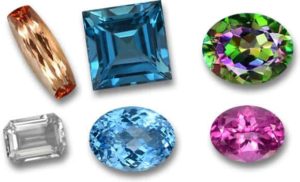
Topaz is a silicate aluminum and fluorine mineral with the Al2SiO4(F, OH)2 chemical formula. Topaz crystallizes in the orthorhombic system, and its crystals are mostly pyramidal and other faces terminated with prismatics. It is one of the hardest naturally occurring minerals (Mohs hardness of 8) and is the most difficult of any mineral silicate. This longevity paired with its normal flexibility and changing.
What Color Is Topaz?
Natural topaz is translucent and colourless, just like natural corundum. The wide range of topaz colors available are due either to natural trace impurities or crystal structural defects. Diversity in color is also caused by changes produced by the gemstone industry. Topaz is available in a variety of colors from yellow, orange, gray, purple, blue, black, violet and green.
Colorless topaz is fairly common and is rarely given a dazzling cut and sold as a diamond replacement. Indeed one of the world’s most famous topaz gemstones is a colorless topaz originally thought to be a diamond.
The most common colors of untreated topaz are pale yellow, brown and gray. Pastel shades of light-green, violet and pink are also found. The most popular topaz color is blue. Indeed, blue topaz is the perennial top selling jewelry stone in the USA.
The most valuable topaz colour known as imperial topaz, is an orange to pink colour. The exact color is not well known for imperial topaz, so a wide range of golden orange, peach and pink topaz are offered under this name. Several light-pink topaz gems are the result of treatment with heat.
What is the rarest color of topaz?
Imperial Topaz, also known as Precious Topaz is the rarest and most valuable of the Topaz family, coming in colors ranging from golden yellow to the extremely prized sherry pink color.
What causes color in topaz ?
Tpoaz which is aluminum flurosilicate is normally colorless in the absence of impurities. The main impurity contained in topaz is iron, but iron does not directly impart any color to topaz as chromium impurities do in rubies, which impart the red color. Within rubies the chromium atoms are directly excited by the absorption of visible light photons. As they return to their ground states, the chromium atoms that leap to an excited state emit light in the red region of the visible spectrum. In the case of topaz, the iron atoms create another unstable species in the crystal and this new species moves to an excited state by absorbing a visible photon of light that emits light from different regions of the spectrum, depending on their wavelength, as they return to the earth, giving rise to the variety of colors found in topaz, including the golden yellow or golden brown color
Naturally colored topaz like yellow, orange and brown topaz contain stable to light color centers. If a colorless topaz is irradiated by ultraviolet light, x-rays, gamma rays or high-energy electrons, we can get a color of yellow, orange or gray, but this color is typically unstable and will disappear in light after a few days. But blue topaz created by irradiation creates color centers that are stable like natural blue topaz color centers and therefore do not fade in light. Only heating will kill these color centers, when the topaz is colorless again.
Color varieties are often known simply by the name of the hue— blue topaz, green topaz, and so on — but there are a few special trade names, too. Imperial topaz is a medium to deep-red reddish orange. This is one of the most expensive shades of the stone. Sherry topaz-named after the sherry wine-is a brown to orange color or brownish. Stones are often called precious topaz in this color range to help differentiate them from the closely colored but less costly citrine and smoky quartz.










